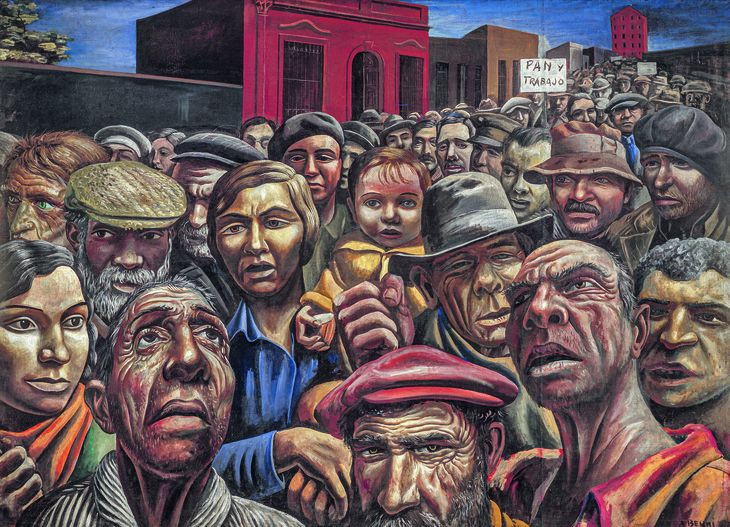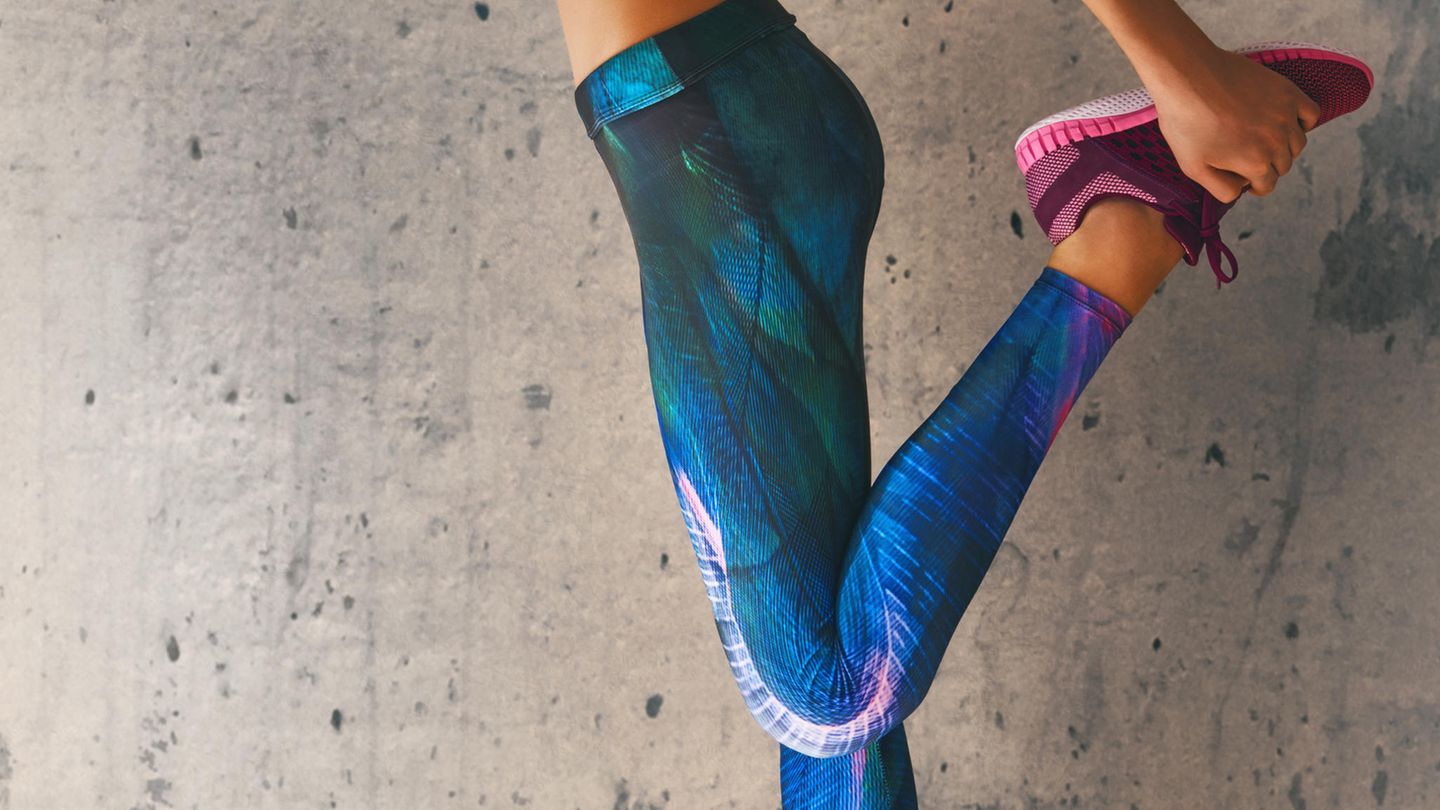Malba presents “Manifestation”a monumental temple on burlap Antonio Berni reinterpreted in a contemporary key by the artists of the Mondongo group, Juliana Laffitte and Manuel Mendanha. Both works bring to the present the painful social and economic situation of Argentina in the infamous decade. “Manifestation” It has a transcendental meaning for Malba, an institution dedicated to Latin American art. Starting in the 1930s, Berni opens a new horizon for Argentine art with New Realism, a theoretical support that sustains and unites “Manifestation” with a large part of the works exhibited in this museum.
In Paris, Berni He had found a personal style within surrealism. He was barely 25 years old when he returned to Argentina and discovered the crisis, unemployment and misery. He then rethought his position as an artist. His dramatic experience led him to found the New Realism, movement connected to social events. He was still living in Paris in 1928 when he exhibited his first surrealist works at the Friends of Art Society.
In 1932 he held the first surrealist exhibition that was presented in the country at the same institution. But while he was painting these last works in his native Rosario, Berni He distanced himself from the avant-garde of Paris. “You saw the palpable cruelty of misery in the streets”. And he clarifies that surrealism revealed its most “absolute inadequacy to the historical moment and to the truth of my personal life in those circumstances.”
The latest surrealist works of Berni They date back to 1932. But when he exhibited them, his mind was already on something else. And so he says it: “It was 1931. The economic crisis was taking its toll. The line of unemployed people was in front of the soup kitchen. Then I started to make compositions with social content. In ‘La Manifestación’ and ‘Desocupados’. I myself was unemployed…”
Although these large paintings are dated 1934, the artist’s testimonies allow us to deduce that they were conceived, thought and imagined beforehand. That is, prior to the arrival of David Alfaro Siqueiros and all the interest and controversy unleashed in 1933 with his preaching on muralism and committed art. In the years that pass between the return to Argentina and the presentation of “Demonstration” and “Unemployed”, in 1934, Berni’s aesthetic evolution determined a radical change. However, it is appropriate to ask what Berni painted in 1932 and 1933? If only in 1934 he dates his works in mural format, what was he doing before? The question is not resolved.
Berni-Manifestation (2) malba .jpg
The original work of Antonio Berni.
The original work
“Manifestation” reveals factors that establish the modernity of the worksuch as the use of photography with a social nature that Berni He inaugurated with his Leica in the prostitutes’ neighborhood, the effects of light, the cinematographic framing and the theatrical presence of the heroic-looking characters. The poster “Bread and Work” draws an arc towards the past, to meet “Without bread and work” of From the Cárcova and, towards the future, with the work of Tripe. The cycles of poverty in Argentina from 1890, 1930 and today become visible like never before.
In Rosario, Berni It brings together artists around their ideas. When Siqueiros, forced by political circumstances, painted in Natalio Botana’s villa, “Plastic exercise”a mural populated with nudes and openly depoliticized, hired Berni as an assistant, along with Lino Enea Spilimbergo and Juan Carlos Castagnino, among others. However, when evaluating the master classes that the Argentines received during those three months of forced coexistence, no one mentioned that privileged experience. On the contrary, Berni, although he recognizes the influence of Mexican muralism, he was disappointed with the incongruity between preaching and artistic practice. Furthermore, the location of the mural (the basement of a bourgeois) and its theme (erotic) placed Siqueiros in a bad place.
This defeat of the Mexican is opposed by the triumph of Berni, which manages to install two monumental paintings politically committed to the cause of the proletariat in the bourgeois salons. The mural format without losing the mobile condition of the works, to move them according to your will and not depend on becoming friends with the owner of the walls, is the condition that imposes Berni. Siqueiros delivered to snackthe work and his beautiful wife, a situation that could have weighed in favor of the portable paintings, no matter how large they are.
“Mural painting can only be one of the many forms of expression of popular art. Wanting to make the muralist movement the workhorse of mass art in bourgeois society is to condemn the movement to passivity or opportunism. We have the most palpable proof in Buenos Aires with Siqueiros… despite his success among the layers of intellectuals, that painter could not obtain a single place where he could have a true practical experience of his theoretical position. The pretext of providing a technical experience cannot justify the lack of content. Siqueiros, to make a mural painting, had to tie himself to the first board that the bourgeoisie offered him. Only in this way could he prevent all his work of theoretical dissemination from being drowned in nothing.” Berni said.
With the necessary authority to leave behind the Argentina that always looked towards Europe and highlight the Latin American roots, he laid the theoretical foundations of the movement, the “New Realism is ours and belongs specifically to Latin America”. With a critical view of the “old” veristic realism and post-impressionism, the movement of Berni It is related to other realisms that emerged in Latin America, whose first antecedent is Mexican muralism.
The Latin Americanist position implies a clear rejection of Socialist Realism, the propaganda art of Soviet cultural policy. Considering man only as a member of the masses and denying creative individuality, determined the rejection. “Socialist Realism was nothing more than a vulgar verismo…a forced regression whose failure was more than foreseeable”.
Berni He categorically defended himself against the accusations of using “Socialist Realism” that were imposed on him. Rosemary Brest. “Mine does not have a political content, but rather a philosophical content,” he says. “It is a humanistic attitude…, based on my experiences in the world. It is also a sense of justice, equity, a state of love and a feeling of brotherhood.” “New Realism is a certain aesthetic concept and a deep and certain type of humanism. This school affirms the human but simultaneously, to contain it, it affirms the realistic representative as the only and possible envelope.. The humanist conviction that man is the measure of all things, including aesthetic things, is the ultimate justification.
Berni He did not reject the European tradition, nor the avant-garde. And although in New Realism he defended the position of getting rid of foreign influences to go in search of the origin, he rooted his movement in the tradition of Giotto, Leonardo, Goya, Cézanne or Picasso. In this same list he placed Pueyrredón and Pellegrini, realist painters of our history, a link with national culture. Despite the 90 years that separate Berni of Tripe and the new viewers, the words he dedicated to “Manifestation” they remain valid. “The New Realism had to, fatally and preferably, develop in countries like those of Latin America, where the affirmation of the spiritual and material personality is supported, on the one hand, by the prior ideological and sensitive liberation from negative influences, and on the other, in the structuring of a personal and authentic continental culture”.
Source: Ambito
I am an author and journalist who has worked in the entertainment industry for over a decade. I currently work as a news editor at a major news website, and my focus is on covering the latest trends in entertainment. I also write occasional pieces for other outlets, and have authored two books about the entertainment industry.




